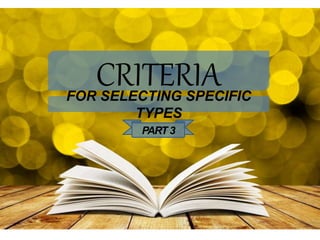
Criteria for Selecting Specific Types of Children's Literature Part 3
- 3. POETRY • First brush of literature for children – Lullabies – Verses – Chants – Tongue twisters • Love the funny sounds more than what they mean • Nonsense humor is enjoyable
- 4. Factors that teachers should consider: • The most popular contents of poetry for children are humor and familiar experiences • A poem enjoyed in Grade 1 may also be enjoyed by some other levels • Children do not like poems they cannot understand
- 5. Factors that teachers should consider: • Literary merit is not always a guarantee that poems will be liked • Children do not like meditative, thoughtful poems • Children prefer “new” poems to more traditional ones • Girls tend to like poetry more
- 6. Factors that teachers should consider: • Aside from humor, children love actions • They prefer a variety of subject matter • They do not like poems with long, descriptive passages • They do not like poems that have unfamiliar figures of speech or archaic language • They do not like pedantic – sounding poems
- 7. An Example • Putak, putak! • Batang duwag • Matapang ka’t nasa pugad!
- 8. An Example • May isang hari • May alilang pusang bungi • Ang buntot pasoli-soli • Ay teka! • Ako’y nagkamali! • Uulitin ko uli.
- 9. Tips for Evaluating Poetry• According to Stewig’s Short List (1988) • Does the poem express how the poet feels in a way that will be clear to the children? • Does the poem present a unique view of something ordinary • Does the poem reinforce the idea that poetry is multiple in topic, in form, or in style?
- 10. Tips for Evaluating Poetry for Older Children• Young people like narrative poems that reflect their inner self • Poem that explore the hidden side of life (which is not often written about) • They enjoy word play, sudden insight, a recollection of childhood or time of emotional intensity • They respond to a beautiful designs
- 11. An Example • Tiririt ng maya • Tiririt ng ibon • Ibig mag asawa’y walang ipalamon • Tiririt ng ibon, tiririt ng maya • Ibig mag asawa’y wala namang kaya
- 13. EVALUATING FICTION • The most number of subtypes among children’s literature • It is usually evaluated according to different aspects namely, – The plot – The setting – The theme – The characterization – The style – The point of view – The format
- 14. EVALUATING FICTION • The Plot 1. Does the book tell a good story? 2. Does it move? 3. Is the plot original and fresh? 4. Is it plausible and credible? 5. Is there a logical series of events? 6. How do the events lead to the climax?
- 15. EVALUATING FICTION • The Setting 1. Where does the story take place? 2. How does the author indicate the time? 3. How does the setting affect the action, characters, or theme? 4. Does the story transcend the setting and have universal implications?
- 16. EVALUATING FICTION • The Theme 1. Is the theme worth imparting to children? 2. Does the theme emerge naturally from the story or is it stated too obviously? 3. Does the story avoid moralizing?
- 17. EVALUATING FICTION • Characterization 1. How does the author reveal the characters? a) Through narration b) In conversation? c) By thoughts of others? d) By thoughts of the character? e) Through action?
- 18. EVALUATING FICTION • Characterization 2. Do we see the strength and weaknesses of the characters? 3. Does the author avoid stereotyping? 4. Is the behavior of the characters consistent with their ages and background? 5. Is there any character development or growth?
- 19. EVALUATING FICTION • Style 1. Is the style of the writing appropriate to the subject? 2. Is the style straightforward or figurative? 3. Is the dialog natural and suited to the characters? 4. How did the author create the mood?
- 20. EVALUATING FICTION • Point of View 1. Does the point of view change? 2. Does the point of view limit the reader’s horizon or enlarge it?
- 21. EVALUATING FICTION • Format 1. Do the illustrations enhance or extend the story? 2. Are they consistent with the story?
- 22. EVALUATING FICTION for Older Children 1. Is it written in a natural, flowing language, much like that which young people use orally? 2. Does it have a wide variety of themes or controversial ideas? 3. Does it provide enjoyment, satisfaction, and literary quality, as well as life, hope, and reality to young people?
- 24. ASSESSING INFORMATIONAL MATERIALS1. Qualification of the author 2. The use of language 3. Accuracy 4. Quality of illustration 5. Organizational and references aids 6. Self-sufficiency
- 25. A Good Piece of Informative Writing has 1. A subject that interest the young 2. It presents new information 3. It has appropriate tone for the intended level 4. Has index and other aids 5. Has information for further readings 6. A competent author with expertise on the subject matter
- 26. PICTURE BOOKS
- 27. CHOOSING PICTURE BOOKS • Most significant book for young readers • Though not all picture books can be judge the same way, the following guide is somehow appropriate. 1. Are the characters well – developed? 2. Are stereotypes avoided? 3. What is the quality of the language of the text?
- 28. CHOOSING PICTURE BOOKS 4. Do the illustrations extend the text in any way? 5. If the setting needs so, are the illustrations authentic? 6. Is the medium appropriate for the mood of the story? 7. Is the artistic style appropriate for the story? 8. Do the size of the book, cover design, end papers, title page convey the idea of the book?
